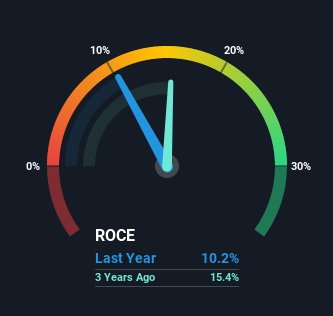InfoBeans Technologies (NSE:INFOBEAN) Is Reinvesting At Lower Rates Of Return
What trends should we look for it we want to identify stocks that can multiply in value over the long term? In a perfect world, we'd like to see a company investing more capital into its business and ideally the returns earned from that capital are also increasing. Ultimately, this demonstrates that it's a business that is reinvesting profits at increasing rates of return. Although, when we looked at InfoBeans Technologies (NSE:INFOBEAN), it didn't seem to tick all of these boxes.
Return On Capital Employed (ROCE): What is it?
If you haven't worked with ROCE before, it measures the 'return' (pre-tax profit) a company generates from capital employed in its business. Analysts use this formula to calculate it for InfoBeans Technologies:
Return on Capital Employed = Earnings Before Interest and Tax (EBIT) ÷ (Total Assets - Current Liabilities)
0.10 = ₹230m ÷ (₹2.5b - ₹202m) (Based on the trailing twelve months to March 2021).
So, InfoBeans Technologies has an ROCE of 10%. In absolute terms, that's a pretty standard return but compared to the Software industry average it falls behind.
View our latest analysis for InfoBeans Technologies

Historical performance is a great place to start when researching a stock so above you can see the gauge for InfoBeans Technologies' ROCE against it's prior returns. If you want to delve into the historical earnings, revenue and cash flow of InfoBeans Technologies, check out these free graphs here.
What Can We Tell From InfoBeans Technologies' ROCE Trend?
On the surface, the trend of ROCE at InfoBeans Technologies doesn't inspire confidence. Over the last five years, returns on capital have decreased to 10% from 36% five years ago. However, given capital employed and revenue have both increased it appears that the business is currently pursuing growth, at the consequence of short term returns. And if the increased capital generates additional returns, the business, and thus shareholders, will benefit in the long run.
What We Can Learn From InfoBeans Technologies' ROCE
Even though returns on capital have fallen in the short term, we find it promising that revenue and capital employed have both increased for InfoBeans Technologies. And the stock has done incredibly well with a 274% return over the last three years, so long term investors are no doubt ecstatic with that result. So should these growth trends continue, we'd be optimistic on the stock going forward.
On a final note, we've found 2 warning signs for InfoBeans Technologies that we think you should be aware of.
While InfoBeans Technologies isn't earning the highest return, check out this free list of companies that are earning high returns on equity with solid balance sheets.
If you decide to trade InfoBeans Technologies, use the lowest-cost* platform that is rated #1 Overall by Barron’s, Interactive Brokers. Trade stocks, options, futures, forex, bonds and funds on 135 markets, all from a single integrated account. Promoted
New: AI Stock Screener & Alerts
Our new AI Stock Screener scans the market every day to uncover opportunities.
• Dividend Powerhouses (3%+ Yield)
• Undervalued Small Caps with Insider Buying
• High growth Tech and AI Companies
Or build your own from over 50 metrics.
This article by Simply Wall St is general in nature. It does not constitute a recommendation to buy or sell any stock, and does not take account of your objectives, or your financial situation. We aim to bring you long-term focused analysis driven by fundamental data. Note that our analysis may not factor in the latest price-sensitive company announcements or qualitative material. Simply Wall St has no position in any stocks mentioned.
*Interactive Brokers Rated Lowest Cost Broker by StockBrokers.com Annual Online Review 2020
Have feedback on this article? Concerned about the content? Get in touch with us directly. Alternatively, email editorial-team (at) simplywallst.com.
About NSEI:INFOBEAN
InfoBeans Technologies
Designs, builds, and manages digital applications in the United Arab Emirates, Germany, India, the United States, and internationally.
Flawless balance sheet with solid track record.
Similar Companies
Market Insights
Community Narratives


Recently Updated Narratives


MINISO's fair value is projected at 26.69 with an anticipated PE ratio shift of 20x


The Quiet Giant That Became AI’s Power Grid


Nova Ljubljanska Banka d.d will expect a 11.2% revenue boost driving future growth
Popular Narratives


The company that turned a verb into a global necessity and basically runs the modern internet, digital ads, smartphones, maps, and AI.


MicroVision will explode future revenue by 380.37% with a vision towards success



